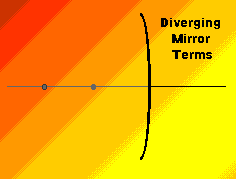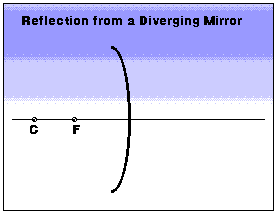

Perhaps you have noticed convex (diverging) mirrors used in many stores for security reasons. These mirrors are also placed in the corner of hallways to enable people to see what is coming toward them around the corner. Many automobile rear-view mirrors are also convex mirrors (the ones that say something like "objects in this mirror may be closer than they appear"). What sort of images appear in a diverging (convex) mirror?
There are some differences between a convex mirror and a concave one, of course. Once you get used to the differences, however, images can be located for convex mirrors using ray diagrams.
First, the center of curvature and focus of a convex mirror are behind the mirror. This means that no light reflected from the convex mirror actually passes through the focus. For this reason the focus of a convex mirror is often referred to as a virtual focus.
